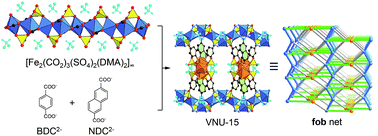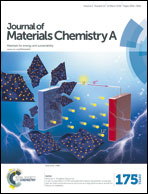High proton conductivity at low relative humidity in an anionic Fe-based metal–organic framework†
Abstract
A metal–organic framework, termed VNU-15 (VNU = Vietnam National University), was synthesized and subsequent detailed structural analysis revealed that the crystalline structure adopted the fob topology. Due to integrated sulphate ligands accompanied by hydrogen-bonded dimethylammonium ions that lined the pore channels of VNU-15, the proton conductivity of this material reached 2.90 × 10−2 S cm−1 at 95 °C and 60% relative humidity. Remarkably, the high proton conductivity of VNU-15 was maintained under these conditions, without any appreciable loss, for 40 h.

- This article is part of the themed collection: 2016 Journal of Materials Chemistry A HOT Papers

 Please wait while we load your content...
Please wait while we load your content...